Computational Evaluation of the Fracture Behavior of Porous Asphalt Concrete Exposed to Moisture and Salt Erosion
Abstract
1. Introduction
2. Objectives
3. Materials and Experiments
3.1. Materials
3.2. Test Methods
3.2.1. Pull-Off Tests
- (1)
- Preparation. Placed asphalt, metal stubs, and basalt specimens in an oven at 170 °C to ensure that the temperature is consistent when making the test samples. The metal stub has a diameter of 20 mm, and the basalt specimen has a height of 50 mm and a diameter of 100 mm.
- (2)
- Making. The heated metal stubs were uniformly coated with the substrate asphalt at its bottom and then placed on the surface of the basalt specimens. Moreover, the prepared samples were conditioned at 25 °C for 24 h until the asphalt fully solidified.
- (3)
- Testing. The samples were placed in an environmental chamber at −10 °C for 4 h. The loading rate of the pull-off tests was 0.6 MPa/s.
3.2.2. SCB Tests
3.2.3. Preparation of Salt Condition Samples
- (1)
- The specimens were conditioned in the salt solution by vacuum saturation using a residual pressure of 98 ± 0.3 kPa for 15 min.
- (2)
- The specimens were placed in an ambient chamber with a temperature of −18 °C for 12 h.
- (3)
- The frozen specimens were placed in a blast oven at 25 °C for 12 h. Since the FAM undergoes deformation at 60 °C, the dissolving temperature was set at 25 °C.
3.3. Experiment Results
4. Model Development and Validation
4.1. Development of SCB FE Model
- (1)
- Data collection on the aggregate plane shape was conducted using the Aggregate Image System (AIMS). These projections were then subjected to image binarization.
- (2)
- The binarized images were imported into discrete element software as templates. It was assumed that FAM uniformly covered the surface of the coarse aggregates. Following the specified gradation in Table 1, the FAM-encased aggregates were randomly placed without overlap in specific regions. Gravity was applied to all the aggregates to form the aggregate–aggregate contact network within the PAC, ensuring the transmission of forces. By performing the above options, the contour lines of the concrete section were obtained.
- (3)
- The concrete of FAM and aggregates was proportionally reduced based on the gradation to obtain the contour lines of the aggregates.
- (4)
- Finally, the contour lines of the concrete and aggregates were merged and converted into drawing exchange format (DXF) files. Then, these files were imported into finite element software to develop a heterogeneous PAC finite element model.
4.2. Bilinear Cohesive Zone Model
4.3. FE Model Parameters
4.4. Model Validation
5. Simulation Results and Discussion
5.1. Effect of Salt on Peak Load and Gf
5.2. Effect of Salt on Scalar Stiffness Degradation (SDEG)
5.3. Effect of Void Content on Damage Type of Elements
5.4. Effect of Cohesion and Adhesion on Fracture Behavior
5.5. Effect of Salt on Loading Rate
6. Conclusions
- (1)
- Salt solution accelerates the degradation of asphalt and FAM when subjected to both dry–wet cycle and freeze–thaw cycle conditions. Under 15% salt solution with dry–wet cycles, the adhesive strength and cohesive strength decreased by 14.9% and 22.3% compared to the control group. As the concentration increased from 0% to 15%, the Gf of the FAM decreased by 31.5%. The salt erosion, chloride ions, and expansion pressure caused by salt crystallization can accelerate the deterioration of asphalt and FAM in salt environments.
- (2)
- Dry–wet cycles and freeze–thaw cycles contribute to the deterioration of the PAC. Salt erosion can accelerate this degradation. Flushing treatment before the drying phase can mitigate the impact of salt erosion. This method helps reduce the effects of de-icing salt used for PAC pavements in seasonal frozen areas.
- (3)
- The average SDEG values of the cohesive elements were higher than that of the adhesive elements during the fracture of the PAC. The damaged elements primarily were cohesive elements. This stands in contrast to situations observed in dense-graded asphalt mixture. As the void content increased, the average SDEG value of the cohesive elements increased and surpassed the average SDEG value of the adhesive elements at a void content of approximately 9%.
- (4)
- An increase in cohesion is better for enhancing the fracture resistance of PAC, compared to adhesion. The relative magnitudes of the adhesion and cohesion forces can influence the crack propagation path.
- (5)
- With an increase in the loading rate, the number of damaged elements increased, and the average value of the SDEG decreased under both the untreated group and the salt-treated group. Salt erosion resulted in a higher average SDEG value and a larger number of damaged cohesive elements at each loading rate.
Author Contributions
Funding
Institutional Review Board Statement
Informed Consent Statement
Data Availability Statement
Conflicts of Interest
References
- Cappellesso, V.G.; Van Mullem, T.; Gruyaert, E.; Van Tittelboom, K.; De Belie, N. Bacteria-based self-healing concrete exposed to frost salt scaling. Cem. Concr. Compos. 2023, 139, 105016. [Google Scholar] [CrossRef]
- Das, J.K.; Pradhan, B. Significance of chloride salt type and sulfate salt on chloride transport mechanism of concrete in the presence of corrosion inhibiting admixtures. Constr. Build. Mater. 2023, 387, 131658. [Google Scholar] [CrossRef]
- Li, H.; Zhang, Y.; Guo, H. Numerical simulation of the effect of freeze–thaw cycles on the durability of concrete in a salt frost environment. Coatings. 2021, 11, 1198. [Google Scholar] [CrossRef]
- Golewski, G.L. The Effect of the addition of Coal Fly Ash (CFA) on the control of water movement within the structure of the concrete. Materials 2023, 16, 5218. [Google Scholar] [CrossRef] [PubMed]
- Mączka, E.; Mackiewicz, P. Asphalt mixtures degradation induced by water, frost, and road salt in the 4-PB bending test evaluated by stiffness variability. Road Mater. Pavement 2023, 24 (Suppl. S1), 389–408. [Google Scholar] [CrossRef]
- Ogbon, W.A.; Jiang, W.; Yuan, D.; Xing, C.; Xiao, J. Asphalt mixture performance deterioration in the salty environment based on theoretical calculation. Constr. Build. Mater. 2024, 393, 132096. [Google Scholar] [CrossRef]
- Jiang, Q.; Liu, W.; Wu, S.; Gou, X. Study on the mechanical performance damage in laboratory-simulated periodic salt environment for asphalt concrete. Constr. Build. Mater. 2024, 411, 134306. [Google Scholar] [CrossRef]
- Fakhri, M.; Javadi, S.; Sedghi, R.; Arzjani, D.; Zarrinpour, Y. Effects of deicing agents on moisture susceptibility of the WMA containing recycled crumb rubber. Constr. Build. Mater. 2019, 227, 116581. [Google Scholar] [CrossRef]
- Mączka, E.; Mackiewicz, P. Asphalt mixtures and flexible pavement construction degradation considering different environmental factors. Appl. Sci. 2022, 12, 12068. [Google Scholar] [CrossRef]
- Juli-Gándara, L.; Vega-Zamanillo, Á.; Calzada-Pérez, M.Á. Sodium chloride effect in the mechanical properties of the bituminous concrete. Cold Reg. Sci. Technol. 2019, 164, 102776. [Google Scholar] [CrossRef]
- Jeon, I.; Lee, J.; Lee, T.; Yun, T.; Yang, S. In silico simulation study on moisture-and salt water-induced degradation of asphalt concrete mixture. Constr. Build. Mater. 2024, 417, 135229. [Google Scholar] [CrossRef]
- Zhang, Q.; Huang, Z. Investigation of the microcharacteristics of asphalt mastics under dry-wet and freeze-thaw cycles in a coastal salt environment. Materials 2019, 12, 2627. [Google Scholar] [CrossRef] [PubMed]
- Guo, R.; Zhang, H.; Tan, Y. Influence of salt dissolution on durable performance of asphalt and self-ice-melting asphalt concrete. Constr. Build. Mater. 2022, 346, 128329. [Google Scholar] [CrossRef]
- Zhang, R.; Tang, N.; Zhu, H. The effect of sea salt solution erosion on cohesion, chemical and rheological properties of SBS modified asphalt. Constr. Build. Mater. 2022, 318, 125923. [Google Scholar] [CrossRef]
- Ogbon, W.A.; Xu, H.; Jiang, W.; Xing, C. Polymer-modified asphalt binders’ properties deterioration under the action of chloride salt. Road Mater. Pavement Des. 2023, 24, 2069–2089. [Google Scholar] [CrossRef]
- Zhang, K.; Luo, Y.; Li, Z.; Zhao, Y.; Zhao, Y. Evaluation of performance deterioration characteristics of asphalt concrete in corrosion environment formed by snow-melting agents. J. Mater. Civ. Eng. 2022, 34, 04021481. [Google Scholar] [CrossRef]
- Chen, X.; Ren, D.; Tian, G.; Xu, J.; Ali, R.; Ai, C. Influence of salt dissolution on durable performance of asphalt and self-ice-melting salt and acid erosion environments based on multi-scale analysis. Constr. Build. Mater. 2023, 366, 130177. [Google Scholar] [CrossRef]
- Shadman, M.; Ziari, H. Laboratory evaluation of fatigue life characteristics of polymer modified porous asphalt: A dissipated energy approach. Constr. Build. Mater. 2017, 138, 434–440. [Google Scholar] [CrossRef]
- Manrique-Sanchez, L.; Caro, S. Numerical assessment of the structural contribution of porous friction courses (PAC). Constr. Build. Mater. 2019, 225, 754–764. [Google Scholar] [CrossRef]
- Shahnewaz, S.M.; Masri, K.A.; Ghani, N.A.A.A.; Jaya, R.P.; Choo, C.S.; Giannakopoulou, P.P.; Petrounias, P. Porous asphalt mixtures enriched with bamboo fibers as a new approach for future sustainable construction. Constr. Build. Mater. 2023, 407, 133456. [Google Scholar] [CrossRef]
- Wu, H.; Yu, J.; Song, W.; Zou, J.; Song, Q.; Zhou, L. A critical state-of-the-art review of durability and functionality of open-graded friction course mixtures. Constr. Build. Mater. 2020, 237, 117759. [Google Scholar] [CrossRef]
- Limón-Covarrubias, P.; Avalos Cueva, D.; Valdés Vidal, G.; Reyes Ortiz, O.J.; Adame Hernández, R.O.; Galaviz González, J.R. Analysis of the behavior of sma mixtures with different fillers through the semicircular bend (SCB) fracture tests. Materials 2019, 12, 288. [Google Scholar] [CrossRef] [PubMed]
- Yee, T.S.; Hamzah, M.O. Evaluation of moisture susceptibility of asphalt-aggregate constituents subjected to direct tensile test using imaging technique. Constr. Build. Mater. 2019, 227, 116642. [Google Scholar] [CrossRef]
- Mihandoust, M.; Ghabchi, R. Mechanical, thermodynamical, and microstructural characterization of adhesion evolution in asphalt binder-aggregate interface subjected to calcium chloride deicer. Constr. Build. Mater. 2023, 408, 133663. [Google Scholar] [CrossRef]
- Chaturabong, P.; Bahia, H.U. Effect of moisture on the cohesion of asphalt mastics and bonding with surface of aggregates. Road Mater. Pavement 2018, 19, 741–753. [Google Scholar] [CrossRef]
- Daryaee, D.; Vamegh, M. Feasibility Study for Evaluating the Moisture Resistance of Asphalt Mixtures Containing RAP Using Pull-off Test. J. Test. Eval. 2022, 50, 2103–2115. [Google Scholar] [CrossRef]
- Motevalizadeh, S.M.; Sedghi, R.; Rooholamini, H. Fracture properties of asphalt concrete containing electric arc furnace slag at low and intermediate temperatures. Constr. Build. Mater. 2020, 240, 117965. [Google Scholar] [CrossRef]
- Guo, Q.; Li, G.; Gao, Y.; Wang, K.; Dong, Z.; Liu, F.; Zhu, H. Experimental investigation on bonding property of asphalt-aggregate interface under the actions of salt immersion and freeze-thaw cycles. Constr. Build. Mater. 2019, 206, 590–599. [Google Scholar] [CrossRef]
- Wang, X.; Ren, J.; Gu, X.; Li, N.; Tian, Z.; Chen, H. Investigation of the adhesive and cohesive properties of asphalt, mastic, and FAM in porous asphalt concrete. Constr. Build. Mater. 2021, 276, 122255. [Google Scholar] [CrossRef]
- Zokaei, M.; Hesami, S. Prediction of fatigue crack behaviour of carbon fibre reinforced asphalt using fracture testing and modelling of the adhesive zone 50. Int. J. Pavement Eng. 2024, 25, 2301452. [Google Scholar] [CrossRef]
- Khan, Z.H.; Amanul Hasan, M.; Tarefder, R.A. Phase field approach to damage and fracture in asphalt concrete using multiscale finite element modeling of an instrumented pavement section. Eng. Fract. Mech. 2022, 272, 108686. [Google Scholar] [CrossRef]
- Caro, S.; Manrique-Sanchez, L.; Kim, Y. Computational evaluation of long-term ravelling susceptibility of permeable friction courses (PAC). Constr. Build. Mater. 2021, 291, 123306. [Google Scholar] [CrossRef]
- Manrique-Sanchez, L.; Caro, S.; Arámbula-Mercado, E. Numerical modelling of ravelling in porous friction courses (PAC). Road Mater. Pavement Des. 2018, 19, 668–689. [Google Scholar] [CrossRef]
- Manrique-Sanchez, L.; Caro, S.; Arámbula-Mercado, E. Random generation of 2D PAC microstructures through DEM gravimetric methods. Road Mater. Pavement Des. 2022, 23, 925–941. [Google Scholar] [CrossRef]
- Manrique-Sanchez, L.; Caro, S.; Estrada, N.; Castillo, D.; Alvarez, A.E. Coupled effects of ageing and moisture on the fracture properties of permeable friction courses (PFC). Int. J. Pavement Eng. 2022, 23, 972–984. [Google Scholar] [CrossRef]
- ASTM D4541-17; Standard Tests Method for Pull-Off Strength of Coatings Using Portable Adhesion Testsers. ASTM International: West Conshohocken, PA, USA, 2017.
- AASHTO TP 105-13; Standard Method of Tests for Determining the Fracture Energy of Asphalt Mixtures Using the Semi-Circular Bend Geometry (SCB). American Association of State and Highway Transportation Officials: Washington, DC, USA, 2015.
- Yin, A.; Yang, X.; Zeng, G.; Gao, H. Experimental and numerical investigation of fracture behavior of asphalt concrete under direct shear loading. Constr. Build. Mater. 2015, 86, 21–32. [Google Scholar] [CrossRef]
- Teng, G.; Zheng, C.; Chen, X.; Lan, X.; Zhu, Y.; Shan, C. Numerical fracture investigation of single-edge notched asphalt concrete beam based on random heterogeneous FEM model. Constr. Build. Mater. 2021, 304, 124581. [Google Scholar] [CrossRef]
- Trawiński, W.; Bobiński, J.; Tejchman, J. Two-dimensional simulations of concrete fracture at aggregate level with cohesive elements based on X-ray μCT images. Eng. Fract. Mech. 2016, 168, 204–226. [Google Scholar] [CrossRef]
- Chen, J.; Ouyang, X.; Sun, X. Numerical investigation of asphalt concrete fracture based on heterogeneous structure and cohesive zone model. Appl. Sci. 2022, 12, 11150. [Google Scholar] [CrossRef]
- Zhang, K.; Luo, Y.; Xie, W.; Wu, J. Evaluation of road performance and adhesive characteristic of asphalt binder in salt erosion environment. Mater. Today Commun. 2020, 25, 101593. [Google Scholar] [CrossRef]
- Zhang, H.; Ding, H.; Rahman, A. Effect of asphalt mortar viscoelasticity on microstructural fracture behavior of asphalt mixture based on cohesive zone model. J. Mater. Civ. Eng. 2022, 34, 04022122. [Google Scholar] [CrossRef]

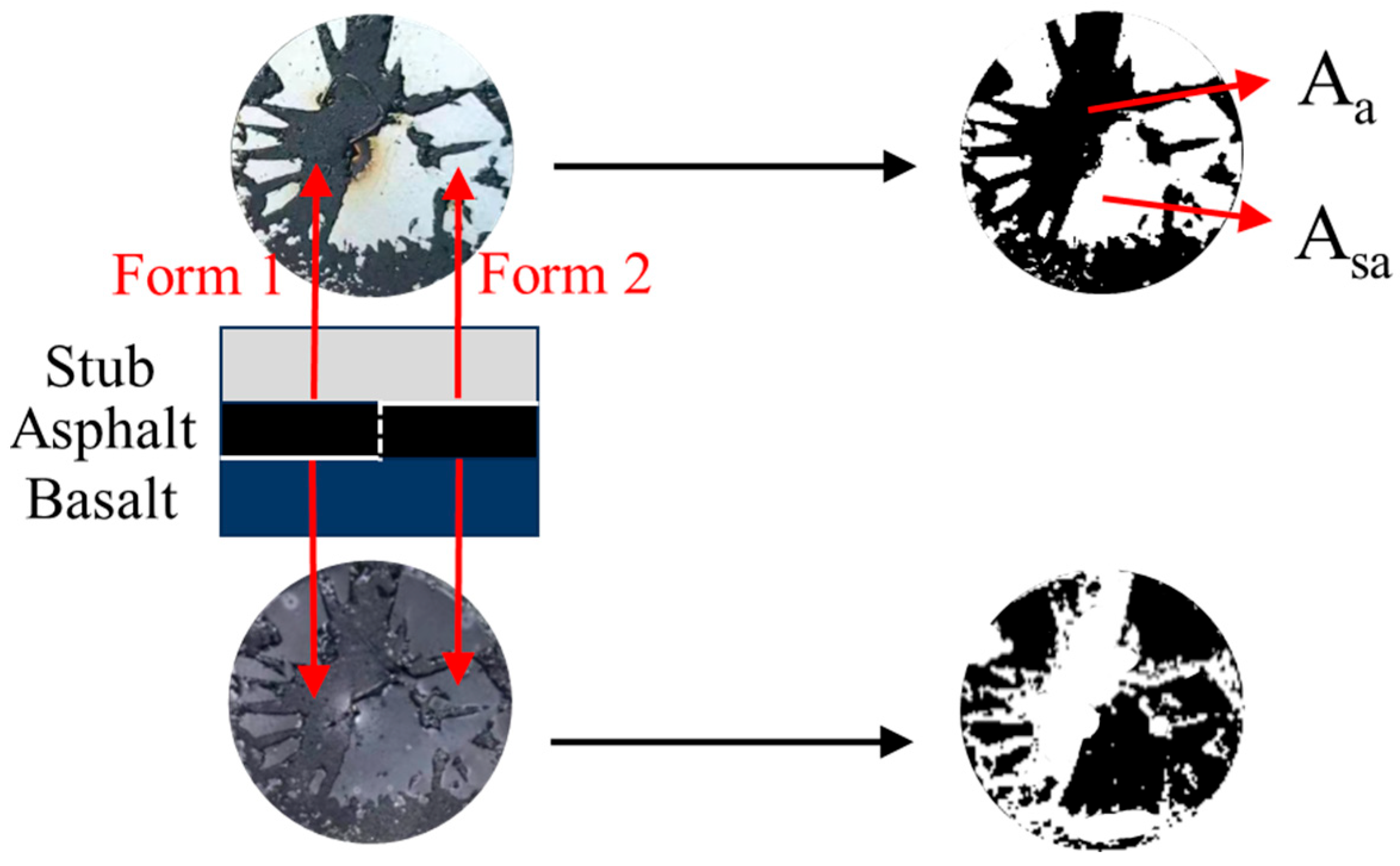
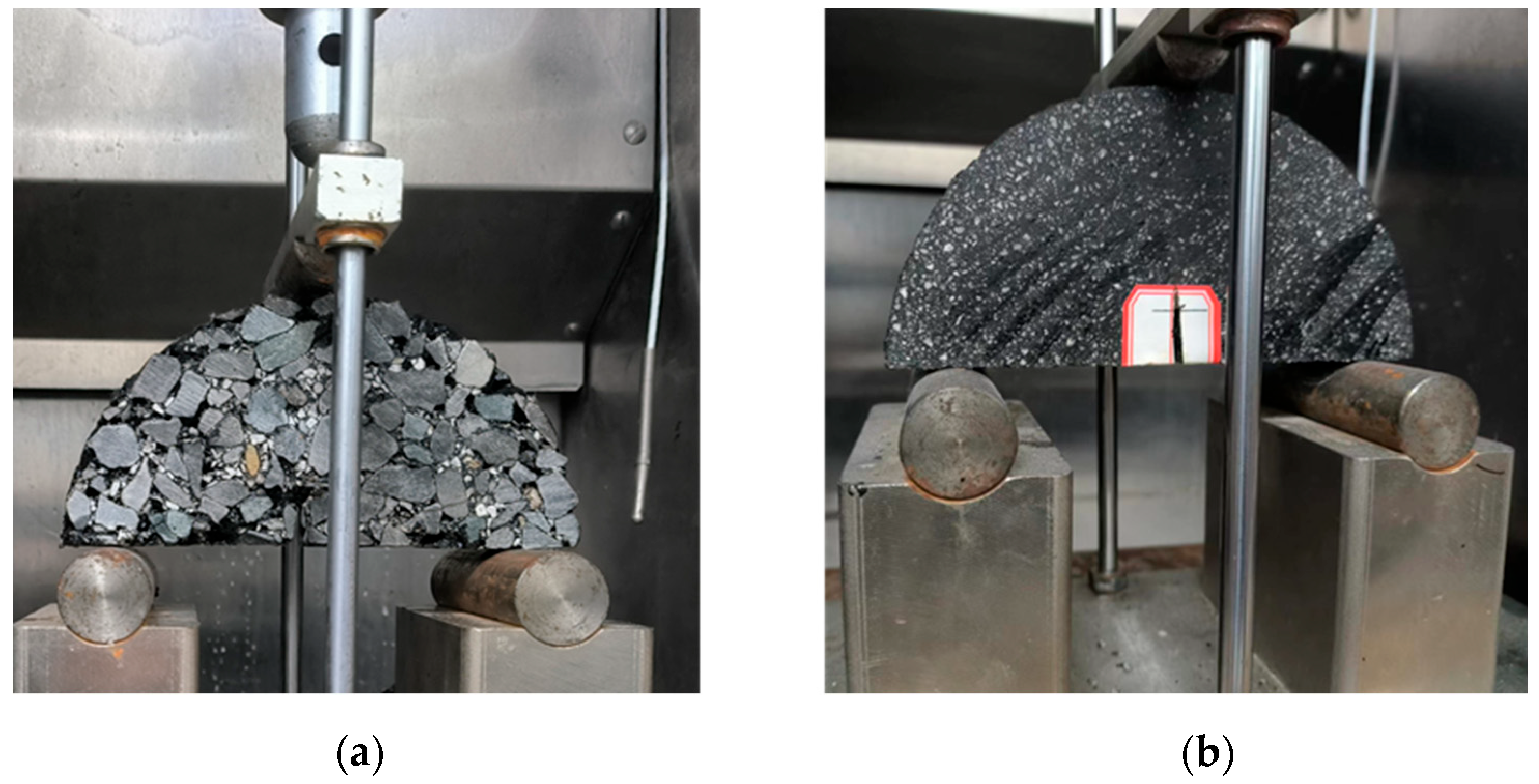
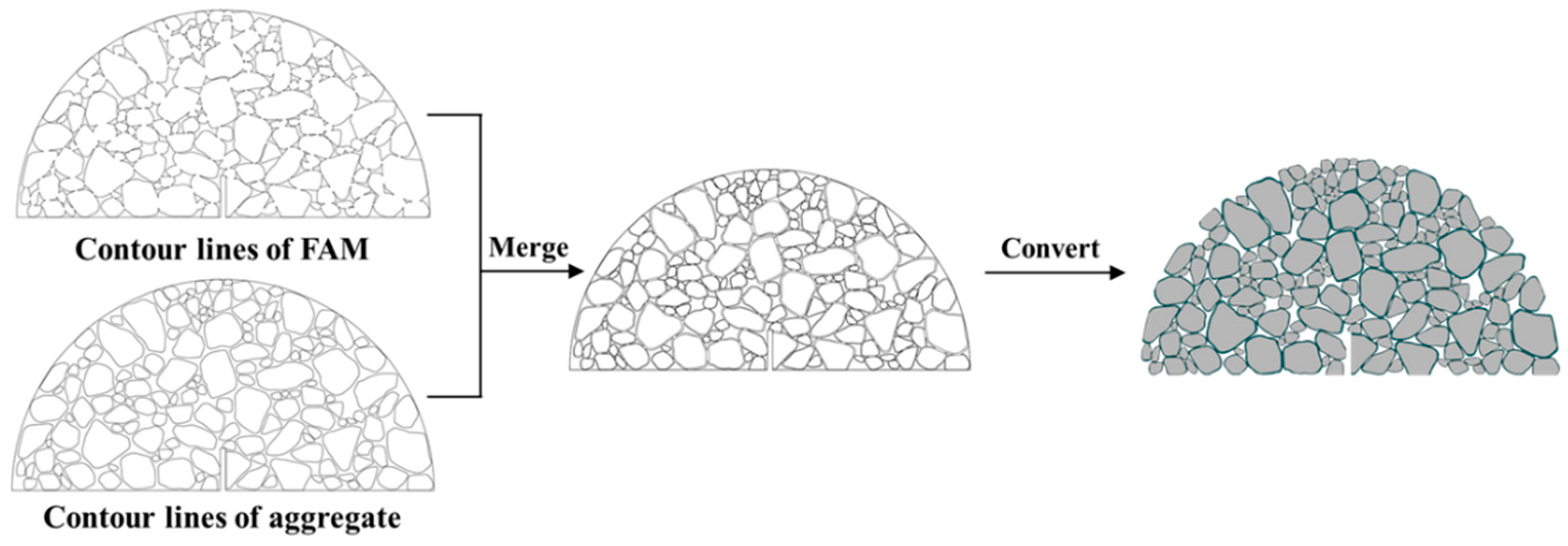

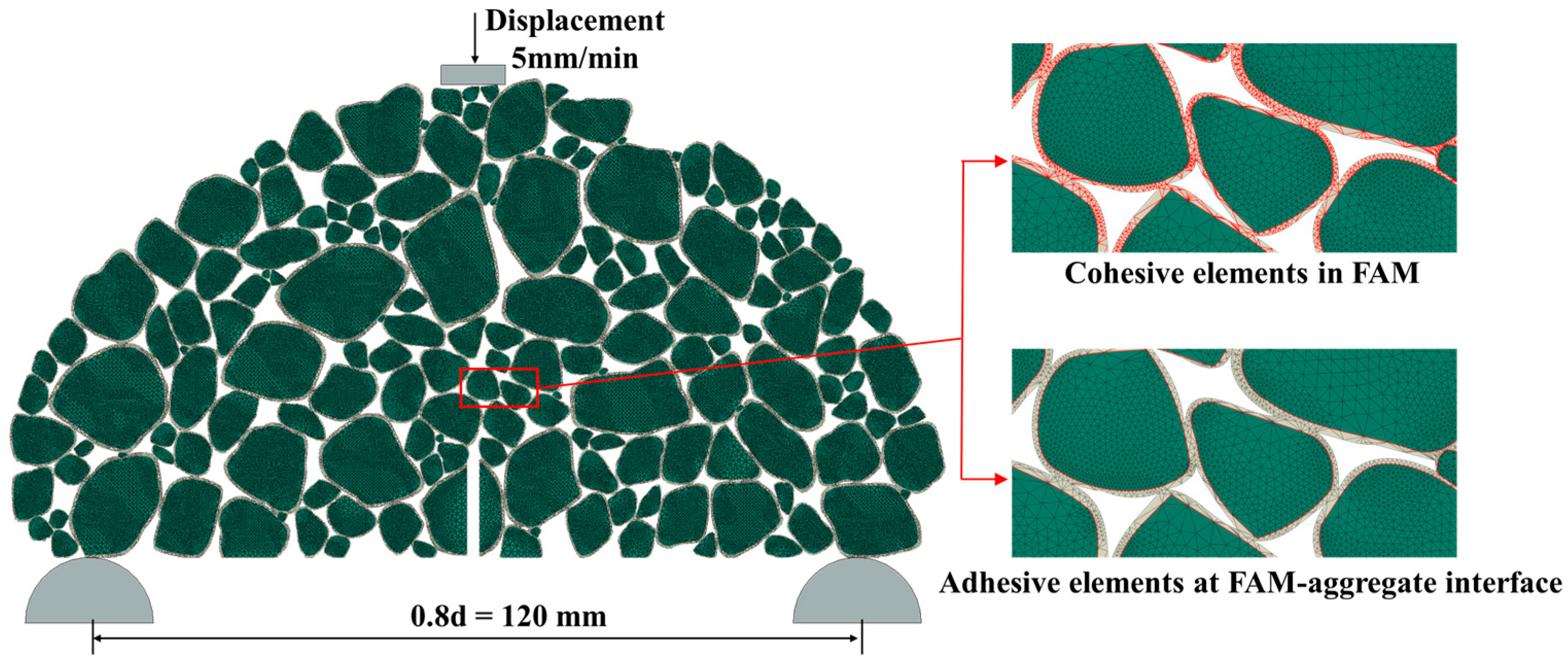
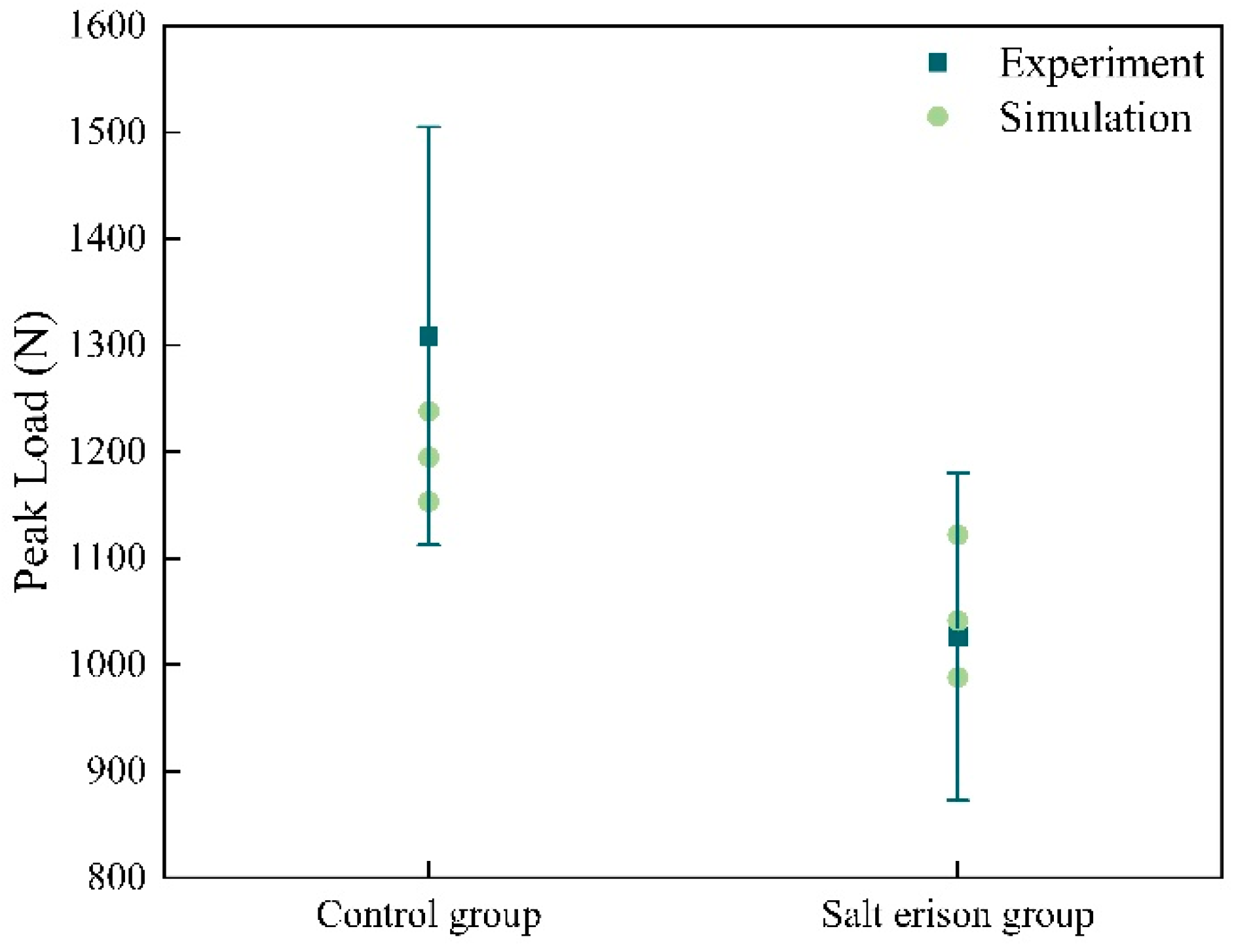

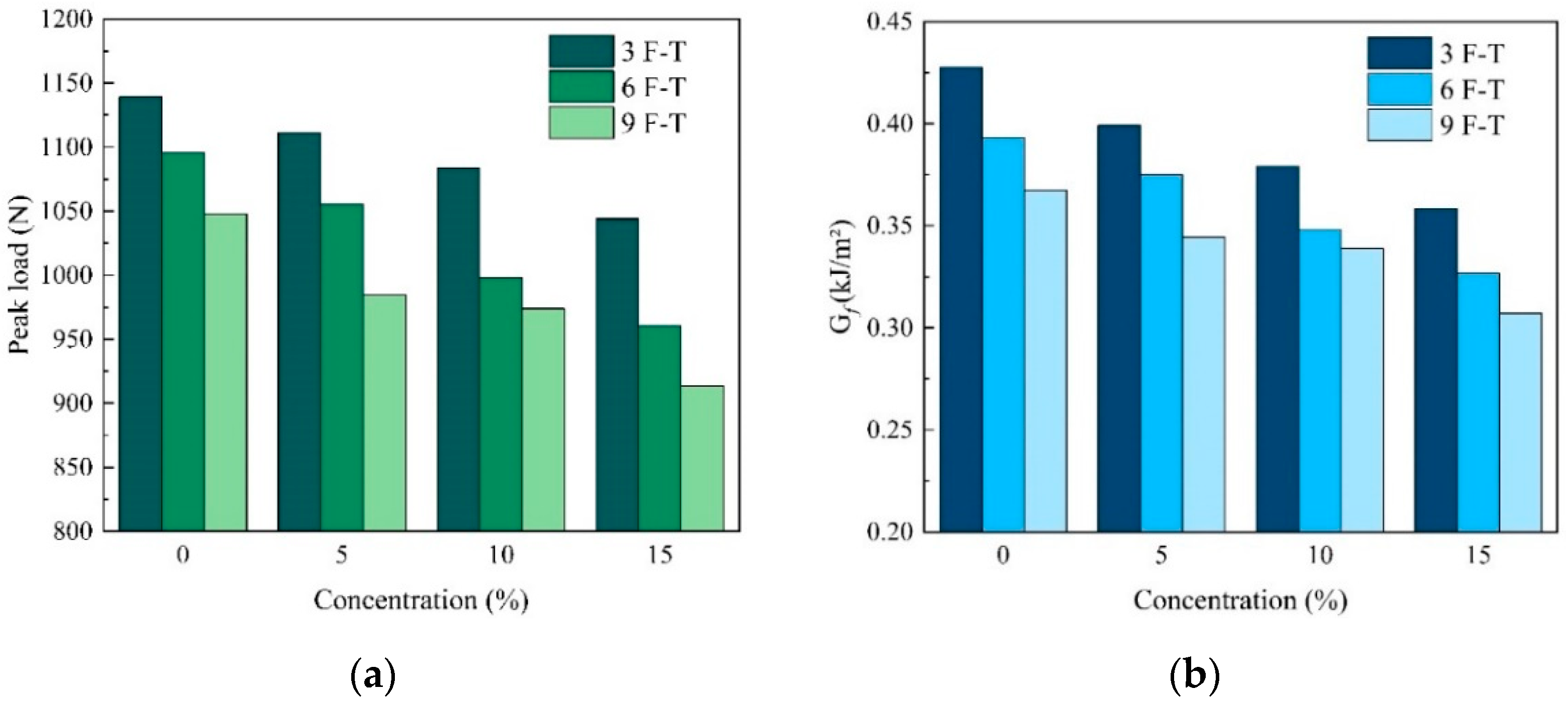
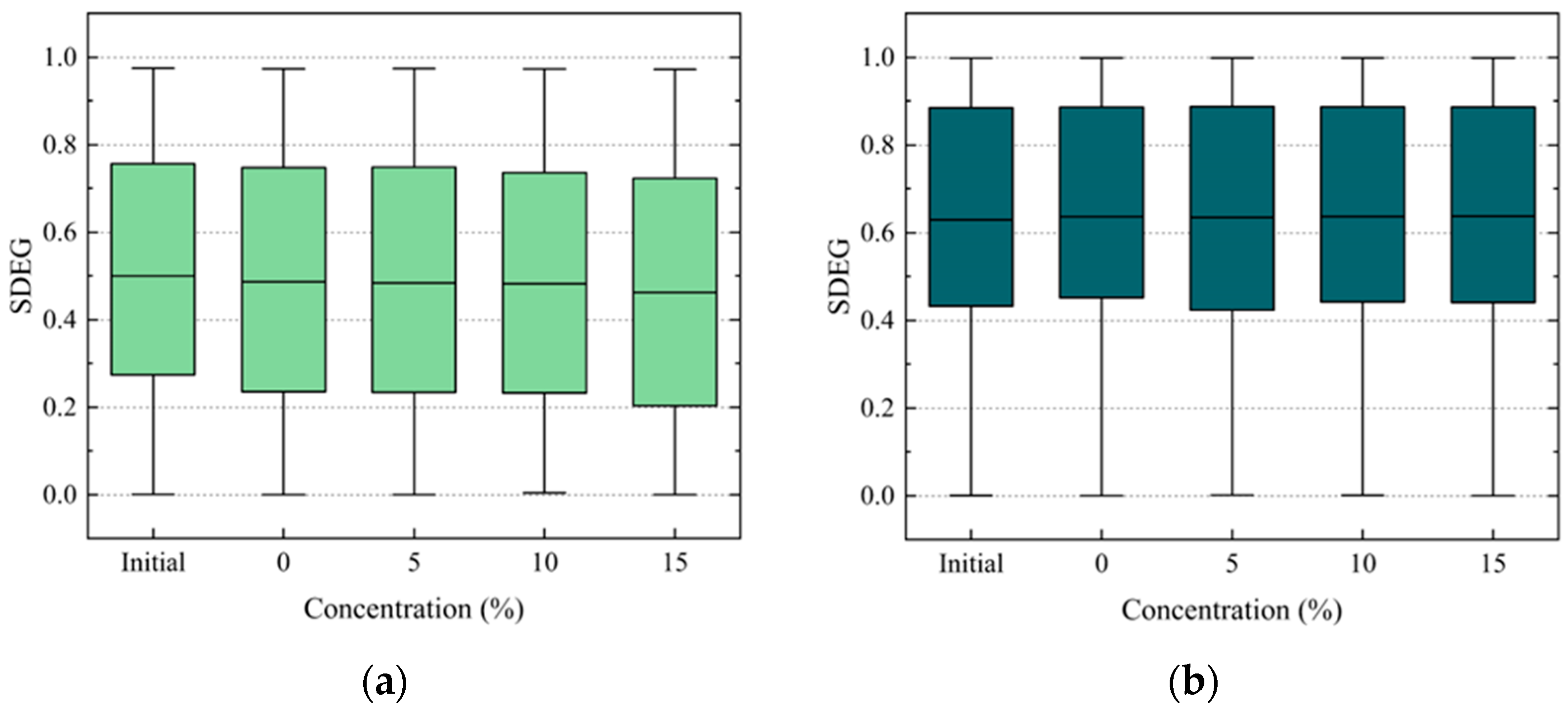
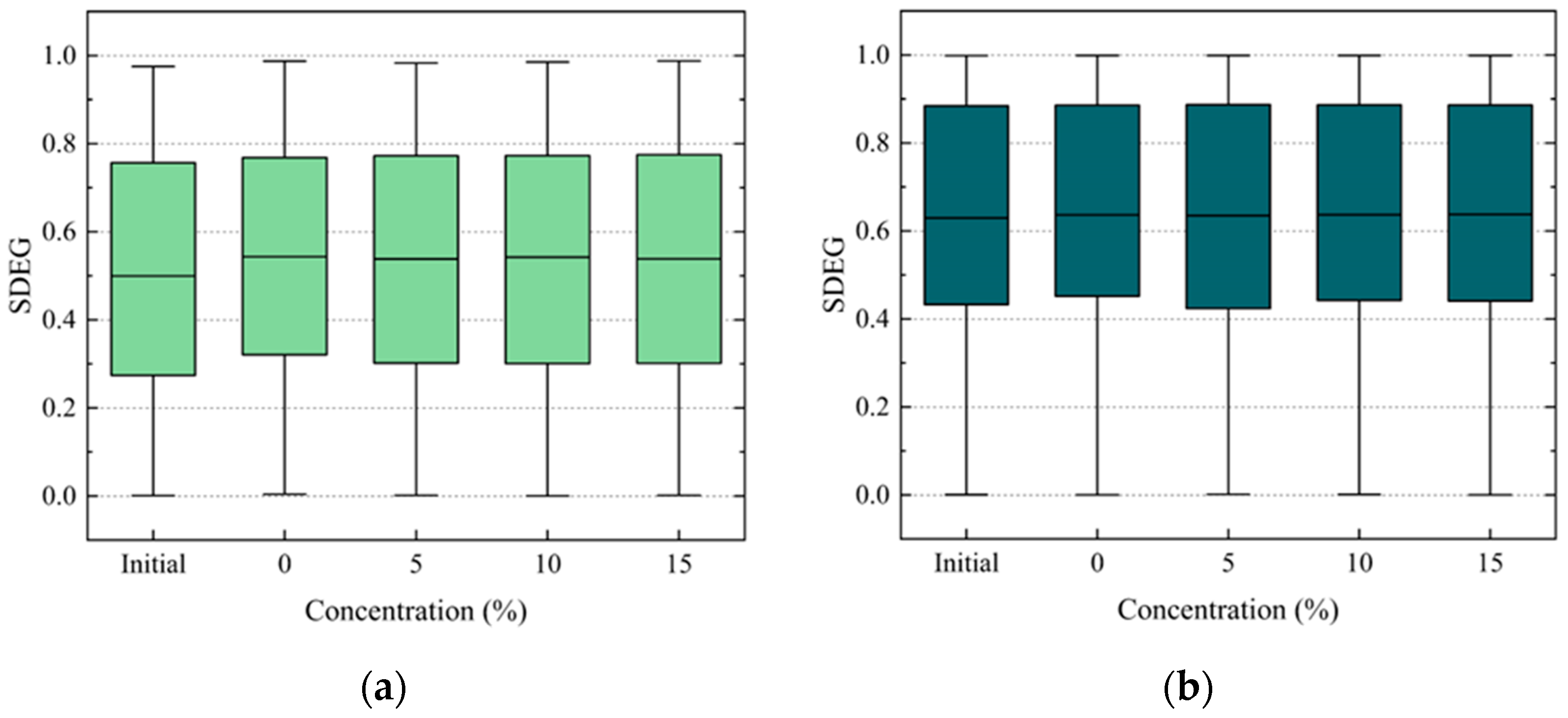
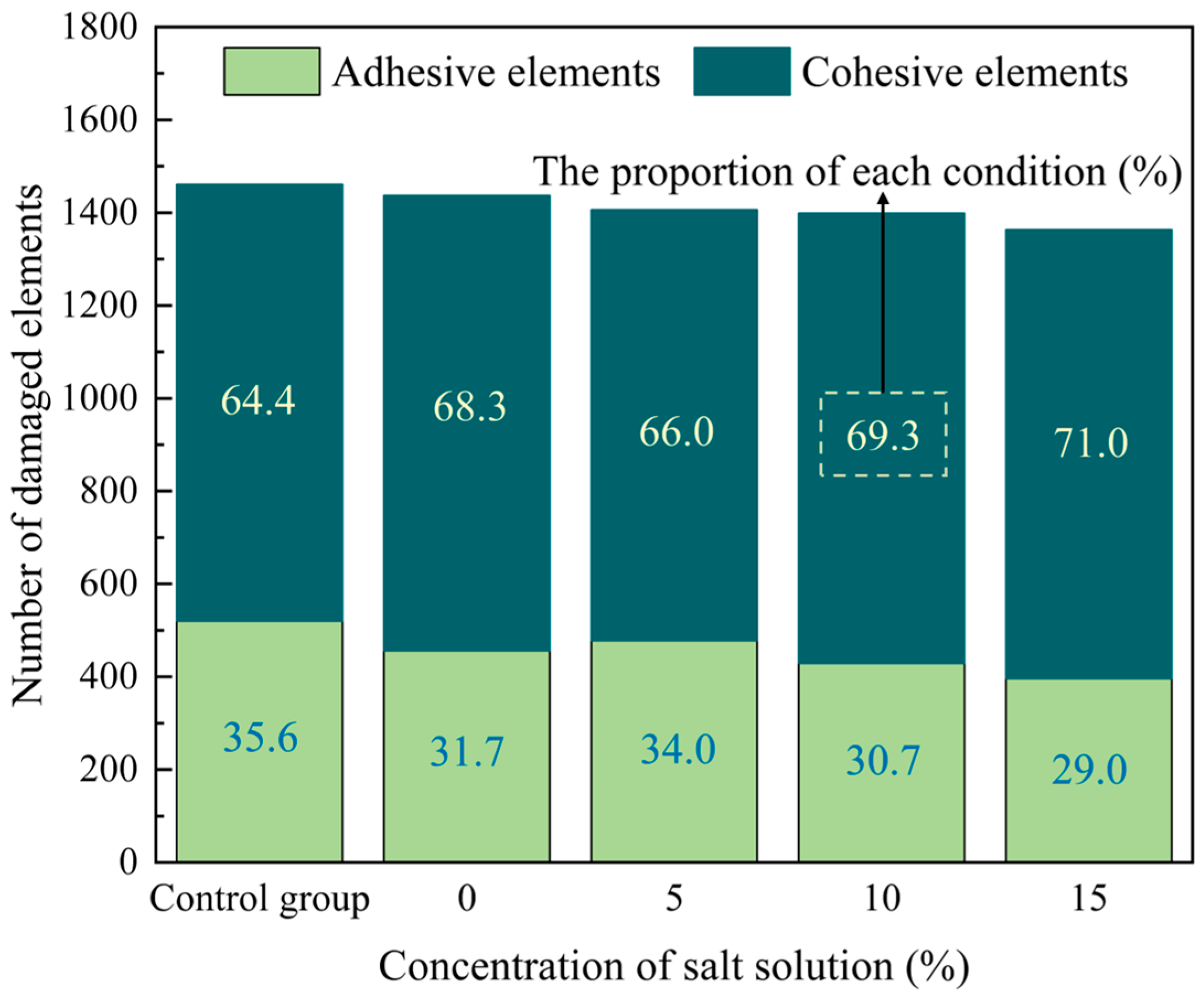
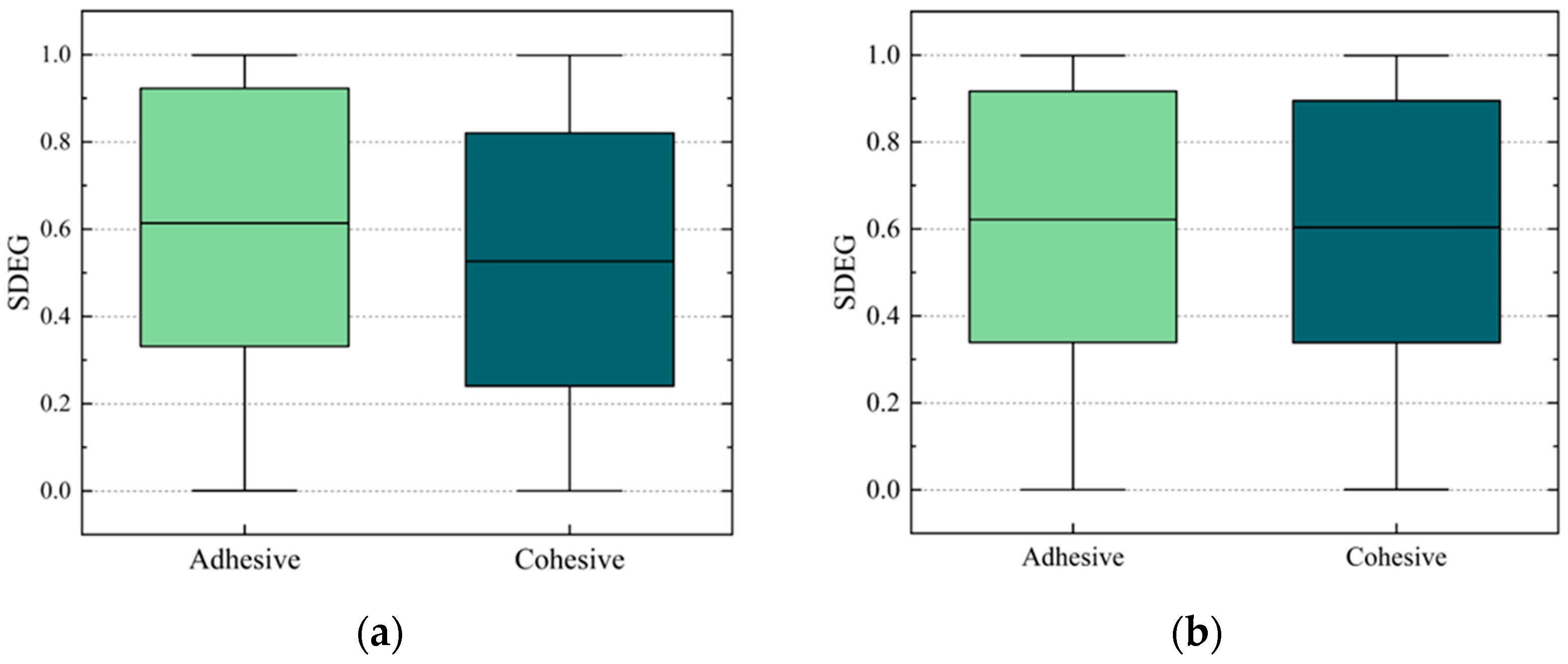
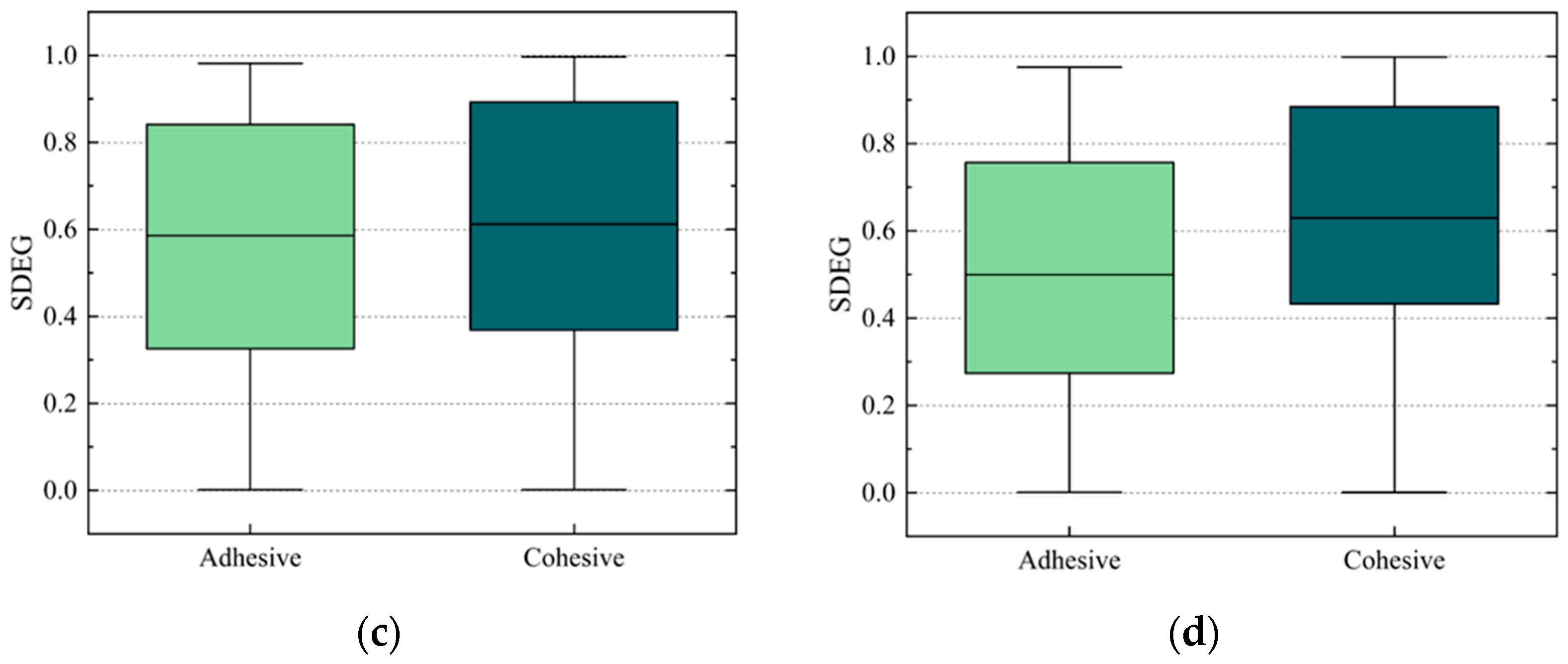
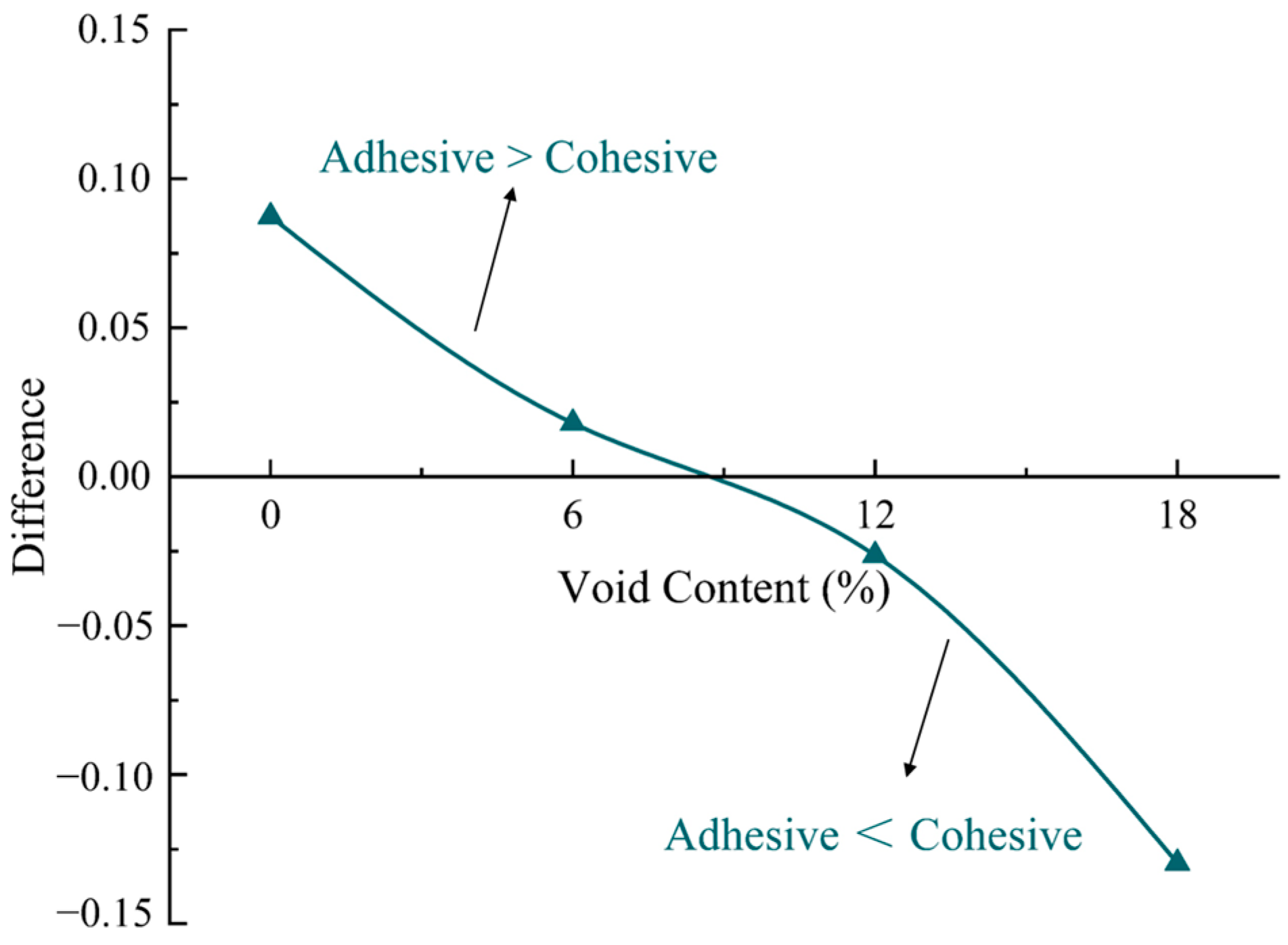
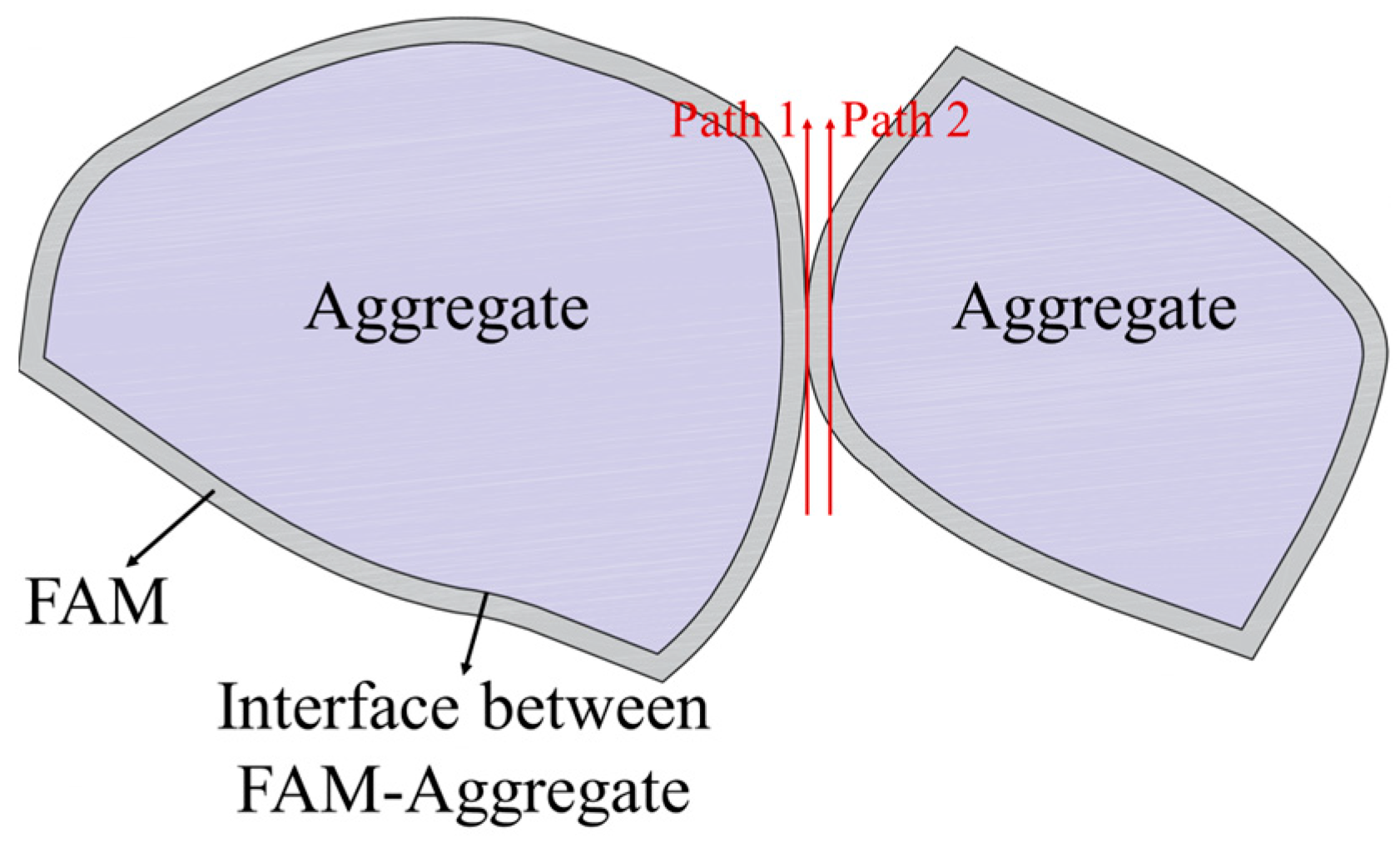
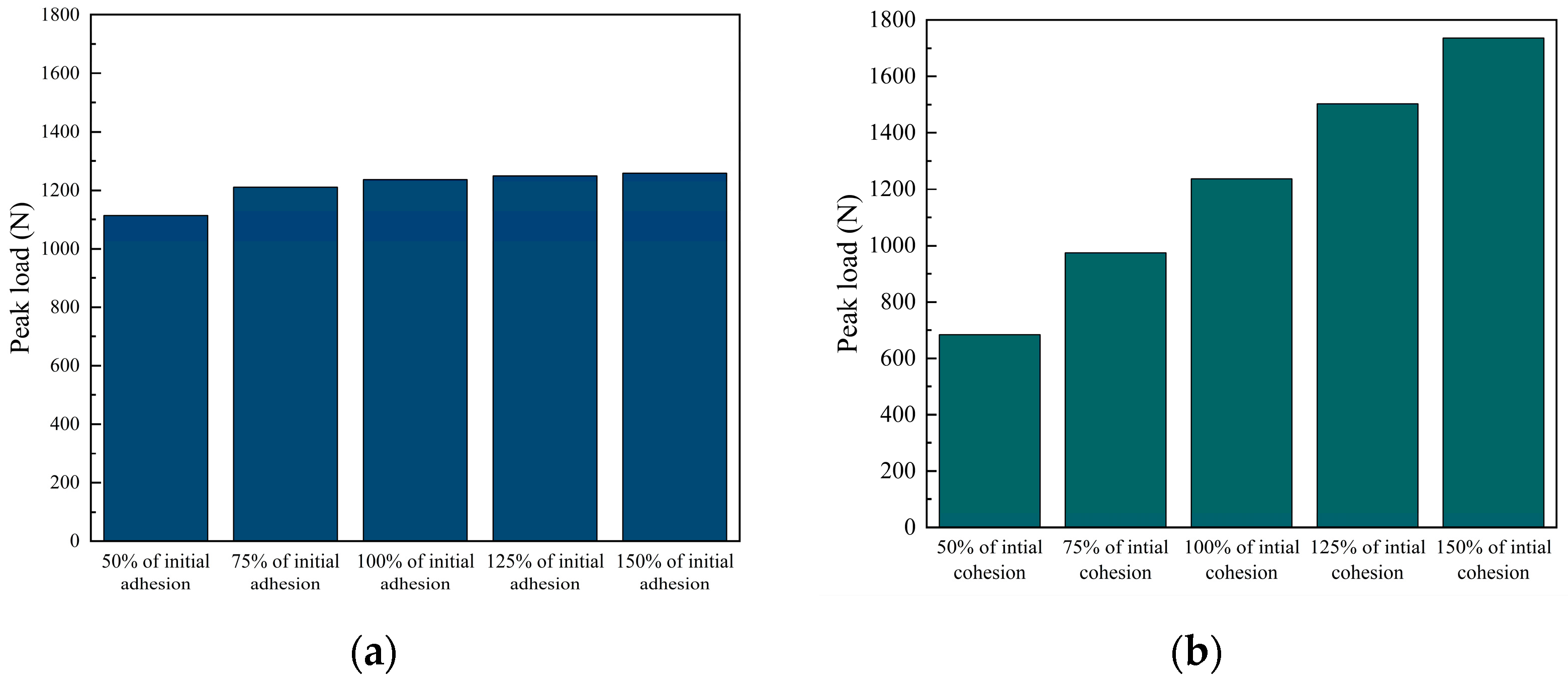
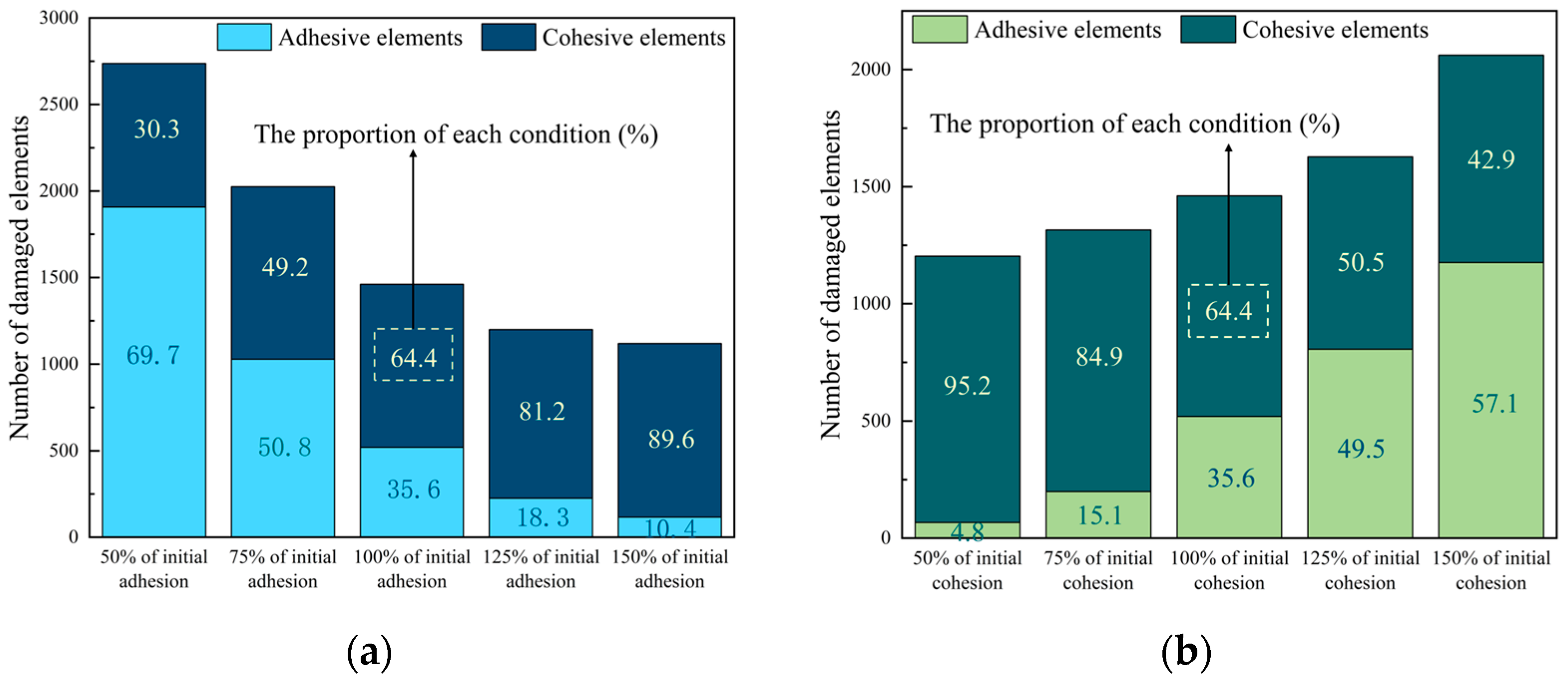
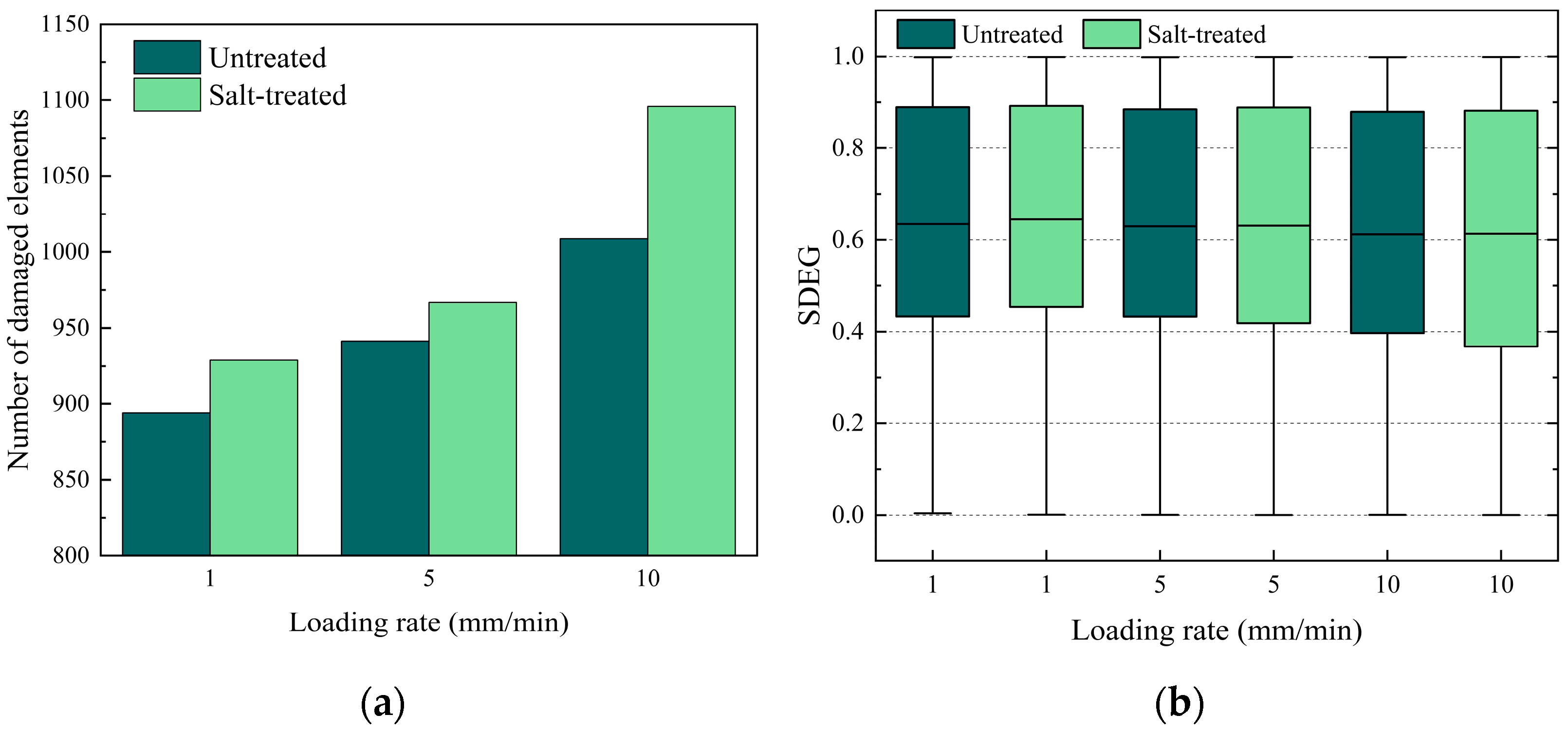
| Sieve Size (mm) | 16 | 13.2 | 9.5 | 4.75 | 2.36 | 1.18 | 0.6 | 0.3 | 0.15 | 0.075 | |
|---|---|---|---|---|---|---|---|---|---|---|---|
| Passing percentage (%) | PAC | 100 | 85.5 | 58.2 | 21.0 | 8.6 | 5.7 | 4.7 | 3.7 | 2.1 | 2.1 |
| FAM | 100 | 100 | 100 | 100 | 100 | 100 | 82.5 | 64.9 | 36.8 | 36.8 | |
| Penetration (25 °C, 0.1 mm) | Ductility (15 °C, cm) | Softening Point (°C) | Density (g/cm3) |
|---|---|---|---|
| 70.0 | >100 | 47.5 | 1.0 |
| Apparent Density (g/cm3) | Water Absorption (%) | Crushing Value (%) | Abrasion Value (%) |
|---|---|---|---|
| 2.7 | 0.9 | 16.0 | 20.1 |
| Tests Conditions | Cycles | Concentration (%) | Adhesive Strength (MPa) | Cohesive Strength (MPa) | Gf of FAM (kJ/m2) |
|---|---|---|---|---|---|
| Control group | 0 | 0 | 6.80 | 7.71 | 3.57 |
| Dry–wet | 12 | 0 | 6.58 | 7.11 | 3.36 |
| 5 | 6.12 | 6.79 | 2.71 | ||
| 10 | 5.90 | 6.28 | 2.56 | ||
| 15 | 5.79 | 5.99 | 2.30 | ||
| Freeze–thaw | 3 | 0 | 6.08 | 7.09 | 3.13 |
| 5 | 5.60 | 6.92 | 3.02 | ||
| 10 | 5.46 | 6.77 | 2.84 | ||
| 15 | 5.38 | 6.52 | 2.66 | ||
| 6 | 0 | 5.82 | 6.79 | 2.99 | |
| 5 | 5.43 | 6.55 | 2.80 | ||
| 10 | 5.39 | 6.18 | 2.54 | ||
| 15 | 5.12 | 5.99 | 2.30 | ||
| 9 | 0 | 5.44 | 6.53 | 2.71 | |
| 5 | 5.15 | 6.09 | 2.52 | ||
| 10 | 5.07 | 6.03 | 2.46 | ||
| 15 | 4.75 | 5.94 | 2.12 |
| Temperature (°C) | g1 | τ1 | g2 | τ2 |
|---|---|---|---|---|
| −10 | 0.09 | 5.11 | 0.84 | 74.37 |
| Phase | E (MPa) | Poisson’s Ratio [41] | σ (MPa) | GI (kJ/m2) |
|---|---|---|---|---|
| Aggregate | 55,500 | 0.15 | ||
| FAM | 1200 | 0.25 | 7.71 | 3.57 |
| Interface | 1200 | 0.25 | 6.80 | 1.79 |
Disclaimer/Publisher’s Note: The statements, opinions and data contained in all publications are solely those of the individual author(s) and contributor(s) and not of MDPI and/or the editor(s). MDPI and/or the editor(s) disclaim responsibility for any injury to people or property resulting from any ideas, methods, instructions or products referred to in the content. |
© 2024 by the authors. Licensee MDPI, Basel, Switzerland. This article is an open access article distributed under the terms and conditions of the Creative Commons Attribution (CC BY) license (https://creativecommons.org/licenses/by/4.0/).
Share and Cite
Liang, Y.; Chen, J.; Li, L. Computational Evaluation of the Fracture Behavior of Porous Asphalt Concrete Exposed to Moisture and Salt Erosion. Materials 2024, 17, 1505. https://doi.org/10.3390/ma17071505
Liang Y, Chen J, Li L. Computational Evaluation of the Fracture Behavior of Porous Asphalt Concrete Exposed to Moisture and Salt Erosion. Materials. 2024; 17(7):1505. https://doi.org/10.3390/ma17071505
Chicago/Turabian StyleLiang, Yuheng, Jiaqi Chen, and Liang Li. 2024. "Computational Evaluation of the Fracture Behavior of Porous Asphalt Concrete Exposed to Moisture and Salt Erosion" Materials 17, no. 7: 1505. https://doi.org/10.3390/ma17071505
APA StyleLiang, Y., Chen, J., & Li, L. (2024). Computational Evaluation of the Fracture Behavior of Porous Asphalt Concrete Exposed to Moisture and Salt Erosion. Materials, 17(7), 1505. https://doi.org/10.3390/ma17071505







